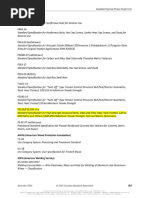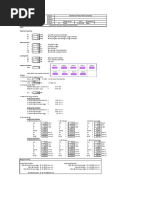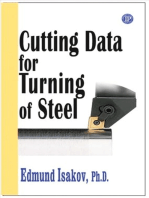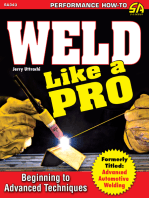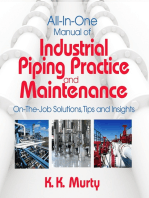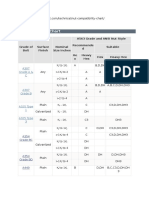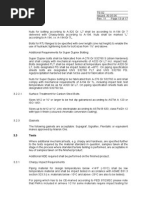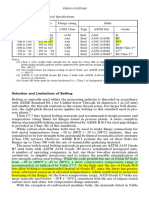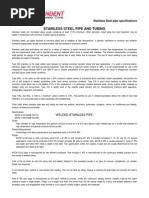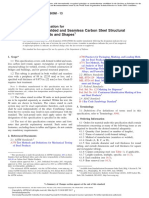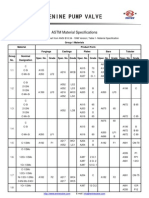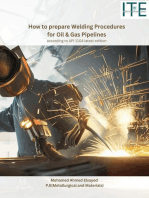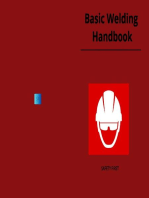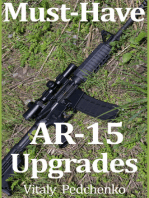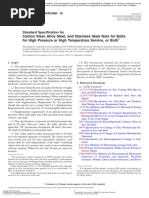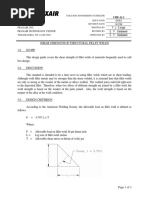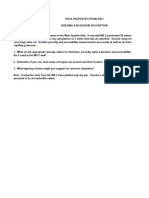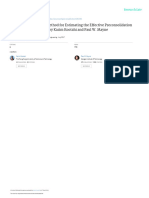Microsoft Word - M001r3
Microsoft Word - M001r3
Uploaded by
Thiago CurvoCopyright:
Available Formats
Microsoft Word - M001r3
Microsoft Word - M001r3
Uploaded by
Thiago CurvoOriginal Title
Copyright
Available Formats
Share this document
Did you find this document useful?
Is this content inappropriate?
Copyright:
Available Formats
Microsoft Word - M001r3
Microsoft Word - M001r3
Uploaded by
Thiago CurvoCopyright:
Available Formats
NORSOK standard M-001 Rev. 3, Nov.
2002
Even if the specification for the deaeration equipment gives more strict requirements, the above shall be
basis for the material selection. If the specified Oxygen Equivalent or temperature is above 50 ppb or 30°C
respectively for normal operation, the basis for material selection shall be subject to special evaluation.
Recommendation:
For carbon steel submarine injection flowlines the corrosion allowance should be minimum 3 mm.
In injection water systems where alternating deaerated seawater, produced water, aquifer water and/or gas
could flow through the systems, the material selection shall take this into account. All components which
may contact injection water or back-flowing fluids, shall be resistant against well treating chemicals or well
stimulating chemicals in case of back-flow situations. For carbon steel piping maximum flow velocity shall be
6 m/s.
5.5.5 Bolting materials for piping, equipment, structural and subsea applications
The general bolting material for bolt diameters above 10 mm in piping systems and equipment shall be
carbon or low alloy steel selected in accordance with the ASTM Standards listed in table 3 below. Bolts with
a diameter < 10 mm shall be stainless steel Type 316 for metal temperatures below 60°C for topside
applications based upon maximum operating temperature.
Table 3 - Temperature range for bolting materials
Temperature BOLT4) NUT Size range,
range, (°C) (mm)
-100/+400 A 320 Grade L7 A 194 Grade 4/S3 or grade <65
7/S3
A 320 Grade L43 A 194 Grade 7/S3 or A194 <100
grade 4/S3
-46/+400 A 193 Grade B7 A 194 Grade 2H All
-29/+540 A 193 Grade B161) A 194 Grade 7 All
-196/+540 A 193 Grade B8M2) A 194 Grade 8M/8MA3) All
NOTES
1 This grade should not be used for permanent subsea equipment. Grade B16 is intended for high temperature service, outside
the temperature range for Grade B7.
2 Type 316 bolts and nuts shall not be used at maximum operating temperature above 60°C if exposed to wet marine
atmosphere.
3 Use 8MA with class 1 bolts.
4 Use of bolting for pressure equipment under PED shall be verified by a PMA.
Bolting materials for structural applications shall generally be carbon or low alloy steels.
The following limitations shall apply:
• For topside applications, the strength class shall not exceed ISO 898 class 10.9.
• For submerged bolts, the strength class shall not exceed ISO 898 class 8.8, ASTM A 320 Grade L7 or A
193 Grade B7.
• Bolts with a diameter above 25 mm shall be impact tested to the same requirements as for the steels to
be bolted.
If other bolting materials are required due to corrosion resistance or other reasons, the material shall be
selected in accordance with the general requirements of this document. For subsea applications, Alloy 625
shall be used when corrosion resistant bolts are required at ambient temperature, i.e. for conditions where
the bolts are exposed to aerated seawater and cathodic protection cannot be ensured. It shall be verified
that the materials have acceptable mechanical properties at the actual design temperatures.
Bolts screwed into component bodies shall be of a material that is compatible with the body with respect to
galling and ability to disassemble the component for maintenance, if relevant. Possibility for galvanic
corrosion, thermal coefficient if relevant, and for subsea applications the effect of cathodic protection, shall
be considered.
NORSOK standard Page 19 of 30
You might also like
- Bolting Pages From CSA S6 (2019) - Canadian Highway Bridge Design CodeDocument3 pagesBolting Pages From CSA S6 (2019) - Canadian Highway Bridge Design CodePubcrawlNo ratings yet
- Astm A519 A519m 17Document6 pagesAstm A519 A519m 17baliNo ratings yet
- BOQ of Proposed Bungalow For Providing Approximate CostDocument13 pagesBOQ of Proposed Bungalow For Providing Approximate CostA.k. Mishra100% (1)
- Structural Analysis TemplateDocument1 pageStructural Analysis TemplateChristian Noel YanesNo ratings yet
- Astm Bolt & NutsDocument24 pagesAstm Bolt & NutsDinesh Radhakrishnan100% (4)
- How To Weld 254 SMODocument12 pagesHow To Weld 254 SMOsateesh chand100% (7)
- Bolt Grip Length PDFDocument1 pageBolt Grip Length PDFmatthewwalls4386100% (2)
- Astm A193 - Nuts and BoltsDocument5 pagesAstm A193 - Nuts and BoltsgarrybieberNo ratings yet
- SS333 1996 Fire DamperDocument18 pagesSS333 1996 Fire DamperAaron Ang100% (2)
- Weld Like a Pro: Beginning to Advanced TechniquesFrom EverandWeld Like a Pro: Beginning to Advanced TechniquesRating: 4.5 out of 5 stars4.5/5 (6)
- All-in-One Manual of Industrial Piping Practice and MaintenanceFrom EverandAll-in-One Manual of Industrial Piping Practice and MaintenanceRating: 5 out of 5 stars5/5 (1)
- Metric DIN 934 Hexagon Nuts: Visit Our For Product AvailabilityDocument4 pagesMetric DIN 934 Hexagon Nuts: Visit Our For Product AvailabilityThiago CurvoNo ratings yet
- ASME b18.3 - 2012 RevisionDocument14 pagesASME b18.3 - 2012 RevisionThiago Curvo100% (1)
- Astm D3330Document6 pagesAstm D3330Thiago Curvo100% (2)
- C 12 FastenersDocument5 pagesC 12 FastenersMithun Unni NairNo ratings yet
- Bolts and Compatible Nuts InformationDocument11 pagesBolts and Compatible Nuts InformationBHARATHNo ratings yet
- 3.3 TestsDocument1 page3.3 TestsgullenariNo ratings yet
- Table 1B List of Bolting Specifications Applicable ASTM SpecificationsDocument1 pageTable 1B List of Bolting Specifications Applicable ASTM Specificationsbabis1980No ratings yet
- Astm A 563 2014Document9 pagesAstm A 563 2014Marlonnog100% (2)
- ASTM Bolting Specification Temperature MDocument2 pagesASTM Bolting Specification Temperature Mrazvan65100% (1)
- OAG-X150-042-SPC-015 Rev A6Document9 pagesOAG-X150-042-SPC-015 Rev A6Riyas SahabNo ratings yet
- Table 1B List of Bolting Specifications Applicable ASTM SpecificationsDocument1 pageTable 1B List of Bolting Specifications Applicable ASTM SpecificationsPanchal ShaileshNo ratings yet
- A354 PDFDocument7 pagesA354 PDFnighat_fatima_12No ratings yet
- Bolting Material Specifications - PIPING HANDBOOKDocument1 pageBolting Material Specifications - PIPING HANDBOOK최승원No ratings yet
- Bolts and NutsDocument1 pageBolts and NutsRiyas SahabNo ratings yet
- Materials Stud Bolts: ASTM A197 B7Document5 pagesMaterials Stud Bolts: ASTM A197 B7scribddisantoNo ratings yet
- Stainless Steel Pipe SpecsDocument3 pagesStainless Steel Pipe SpecsWahyuTantraFauziNo ratings yet
- Technical Data NRL 02301Document8 pagesTechnical Data NRL 02301Attiq Ahmad ChoudhryNo ratings yet
- M PL 033Document19 pagesM PL 033Ali ClubistNo ratings yet
- Astm Material Summary For BoltsDocument2 pagesAstm Material Summary For BoltsAkshay PoddarNo ratings yet
- 3 05 A Welding Specification of Carbon Steel Alloy SteelDocument40 pages3 05 A Welding Specification of Carbon Steel Alloy SteelvancongthanhNo ratings yet
- Juntas Flanchadas, Empaques y PernosDocument8 pagesJuntas Flanchadas, Empaques y Pernosjuancparra20No ratings yet
- Asme Section II A Sa-354Document8 pagesAsme Section II A Sa-354Anonymous GhPzn1xNo ratings yet
- Stainless Steel Pipe SpecificationDocument3 pagesStainless Steel Pipe SpecificationBhairu BaniNo ratings yet
- A 194 - A 194m - 03 Qte5nc9bmtk0ts1sruqDocument16 pagesA 194 - A 194m - 03 Qte5nc9bmtk0ts1sruqfadjarNo ratings yet
- Guidelines and Facilities Required For Fabrication Maintenance of Stainless Steel WagonsDocument14 pagesGuidelines and Facilities Required For Fabrication Maintenance of Stainless Steel WagonsSourav PaulNo ratings yet
- General Notes-PDODocument17 pagesGeneral Notes-PDOkalanithigNo ratings yet
- Sa 193Document18 pagesSa 193Haridev MoorthyNo ratings yet
- Cold-Formed Welded and Seamless Carbon Steel Structural Tubing in Rounds and ShapesDocument6 pagesCold-Formed Welded and Seamless Carbon Steel Structural Tubing in Rounds and Shapesalucard375No ratings yet
- Pressure Vessel Plates, Alloy Steel, Manganese-Molybdenum and Manganese-Molybdenum-NickelDocument3 pagesPressure Vessel Plates, Alloy Steel, Manganese-Molybdenum and Manganese-Molybdenum-Nickeljaskaran singhNo ratings yet
- ASTM Material SpecificationsDocument6 pagesASTM Material SpecificationsLim SenglinNo ratings yet
- Bayu Undan / Darwin LNG Facilities Technical Delivery TermsDocument6 pagesBayu Undan / Darwin LNG Facilities Technical Delivery TermsWidodo MuisNo ratings yet
- How To Weld 254 SMO PDFDocument12 pagesHow To Weld 254 SMO PDFPrabhakar KattulaNo ratings yet
- Fastener Identifi Cation Markings: ASTM, SAE, ISODocument7 pagesFastener Identifi Cation Markings: ASTM, SAE, ISOAditya TanwarNo ratings yet
- Specification For Auto LPG Dispensing StationDocument5 pagesSpecification For Auto LPG Dispensing StationShyBokxNo ratings yet
- Carbon and Alloy Steel Nuts For Bolts For High Pressure or High Temperature Service, or BothDocument12 pagesCarbon and Alloy Steel Nuts For Bolts For High Pressure or High Temperature Service, or BothJaime Bernardo GonzálezNo ratings yet
- A 563 - 00 - Qtu2my1sruqDocument10 pagesA 563 - 00 - Qtu2my1sruqAnderson VelandiaNo ratings yet
- Astm, Sae and Iso Grade Markings and Mechanical Properties For Steel FastenersDocument6 pagesAstm, Sae and Iso Grade Markings and Mechanical Properties For Steel FastenershoannhuNo ratings yet
- Astm A618Document4 pagesAstm A618Mohamed Farouk100% (1)
- Spec_16a1fd07-10c8-4ab7-9aea1705387485563_buyer11.iocl.mathuraDocument12 pagesSpec_16a1fd07-10c8-4ab7-9aea1705387485563_buyer11.iocl.mathuraAAYUSH BHOITENo ratings yet
- Sapa Alloy 6063Document2 pagesSapa Alloy 6063Sachith Praminda RupasingheNo ratings yet
- A4 80Document2 pagesA4 80alwezalokNo ratings yet
- Astm F436 F436M 19Document6 pagesAstm F436 F436M 19a.mitkeesNo ratings yet
- A 414 - A 414M - 01 Qtqxnc9bnde0ts1sruq - PDFDocument5 pagesA 414 - A 414M - 01 Qtqxnc9bnde0ts1sruq - PDFTiến Lượng NguyễnNo ratings yet
- ASME Specification For Fastener MaterialsDocument11 pagesASME Specification For Fastener MaterialsAnonymous IwqK1Nl100% (1)
- Astm A36Document4 pagesAstm A36jemorpeNo ratings yet
- A 928 - A 928M - 04 Qtkyoc9boti4tqDocument6 pagesA 928 - A 928M - 04 Qtkyoc9boti4tqsachinguptachdNo ratings yet
- Bolting Selection Guide For Bolting MaterialDocument5 pagesBolting Selection Guide For Bolting Materialthuyenquyen_vtNo ratings yet
- Stainless Steel Pipe SpecificationDocument3 pagesStainless Steel Pipe Specification1trungson1No ratings yet
- Abstract of ASTM A563 2000Document10 pagesAbstract of ASTM A563 2000Jesse ChenNo ratings yet
- How to prepare Welding Procedures for Oil & Gas PipelinesFrom EverandHow to prepare Welding Procedures for Oil & Gas PipelinesRating: 5 out of 5 stars5/5 (1)
- Astm A194 18 PDFDocument12 pagesAstm A194 18 PDFThiago CurvoNo ratings yet
- Din 975 PDFDocument1 pageDin 975 PDFThiago CurvoNo ratings yet
- Astm 194-2017 PDFDocument13 pagesAstm 194-2017 PDFThiago CurvoNo ratings yet
- DIN1629 1984 Seamless Circular Unalloyed Steel Tubes Subject To Special Requirements PDFDocument11 pagesDIN1629 1984 Seamless Circular Unalloyed Steel Tubes Subject To Special Requirements PDFThiago CurvoNo ratings yet
- Effects of Carbon Nanotube Content On The MechanicalDocument6 pagesEffects of Carbon Nanotube Content On The MechanicalThiago CurvoNo ratings yet
- Iso 898-1 - 2013Document24 pagesIso 898-1 - 2013Thiago CurvoNo ratings yet
- Cálculo Solda FileteDocument3 pagesCálculo Solda FileteThiago CurvoNo ratings yet
- Nuts With Specified Property ClassesDocument2 pagesNuts With Specified Property Classesengrmech2009No ratings yet
- Common Construction Materials and Testing Apparatus or Equipment UsedDocument3 pagesCommon Construction Materials and Testing Apparatus or Equipment UsedRex Saberson100% (2)
- Armfield F1 21 Datasheet v2b Web 1Document1 pageArmfield F1 21 Datasheet v2b Web 1Ibrahim ALsultanNo ratings yet
- SP-353 04Document23 pagesSP-353 04Samved PatelNo ratings yet
- Samabungan Topic 1 (Slope Deflection Method)Document24 pagesSamabungan Topic 1 (Slope Deflection Method)Azhar SabriNo ratings yet
- Solution 2-3 West Sparkle Reservoir DescriptionDocument17 pagesSolution 2-3 West Sparkle Reservoir Descriptionmhuf89No ratings yet
- L2 Francis Turbine 2020 PDFDocument73 pagesL2 Francis Turbine 2020 PDFBalkrishna ChaudharyNo ratings yet
- BridgeDocument6 pagesBridgeAyrah Fatimah . 5INo ratings yet
- Cast Iron Manhole Cover & GratingsDocument4 pagesCast Iron Manhole Cover & GratingsttshareefNo ratings yet
- Page 10 From 1607 Calcs AMAT B81 Stairs PO 126763-10283Document1 pagePage 10 From 1607 Calcs AMAT B81 Stairs PO 126763-10283Rosallind daBombNo ratings yet
- 03 48 00clcDocument5 pages03 48 00clcAira LauzonNo ratings yet
- DocumentDocument16 pagesDocumentNathaniel CorpuzNo ratings yet
- Kootahi Mayne 2017 ClosureDocument28 pagesKootahi Mayne 2017 ClosurethalesgmaiaNo ratings yet
- CAESAR II Course ContentDocument3 pagesCAESAR II Course ContentMurugaraj SelvarajNo ratings yet
- Coefficient of Consolidation and Its Correlation With Index Properties of Remolded SoilsDocument6 pagesCoefficient of Consolidation and Its Correlation With Index Properties of Remolded SoilsSanjeev KumarNo ratings yet
- Soal - Soal Latihan Pondasi TiangDocument6 pagesSoal - Soal Latihan Pondasi TiangNashwa QausarNo ratings yet
- Plumbing Final ProjDocument65 pagesPlumbing Final ProjCharles Kaven Dela Cruz100% (1)
- High Efficiency Cyclones: CECO Fisher-KlostermanDocument2 pagesHigh Efficiency Cyclones: CECO Fisher-Klostermanjayaram432No ratings yet
- Design of Septic Tank Based On IS Codes-Is.2470.1.1985Document24 pagesDesign of Septic Tank Based On IS Codes-Is.2470.1.1985Aizaz Shaikh100% (1)
- Combined Pile Raft Foundations (CPRF) An Appropriate Solution For The Foundations of High Rise Buildings KatzenbachDocument11 pagesCombined Pile Raft Foundations (CPRF) An Appropriate Solution For The Foundations of High Rise Buildings Katzenbachpperic13No ratings yet
- Detail Study of Hydroelectric Power PlantDocument139 pagesDetail Study of Hydroelectric Power PlantDivyansh Singh ChauhanNo ratings yet
- Wing WallDocument30 pagesWing WallJurie_sk3608No ratings yet
- Foundation Engineering Workshop OctoberDocument4 pagesFoundation Engineering Workshop OctoberMichaelNo ratings yet
- Ad-A281 365Document237 pagesAd-A281 365EuNo ratings yet
- Design of Three Cell RCC Box Type Viaduct/ Minor Bridge MNB-02 at Chainage 19+324Document78 pagesDesign of Three Cell RCC Box Type Viaduct/ Minor Bridge MNB-02 at Chainage 19+324Mrinal Koyal100% (1)
- Conserve Water Project ReportDocument21 pagesConserve Water Project Reportvedaant panditNo ratings yet
- Design of Beam To Column SpliceDocument1 pageDesign of Beam To Column SpliceAndro RebuyasNo ratings yet
- Universiti Tun Hussein Onn Malaysia: ConfidentialDocument8 pagesUniversiti Tun Hussein Onn Malaysia: ConfidentialNo NameNo ratings yet
- Proposed Fishpond Concreting and Repraping: NO. Item Particular Unit Unit Price Total Cost Mobilization/ClearingDocument3 pagesProposed Fishpond Concreting and Repraping: NO. Item Particular Unit Unit Price Total Cost Mobilization/ClearingMT JasonNo ratings yet
